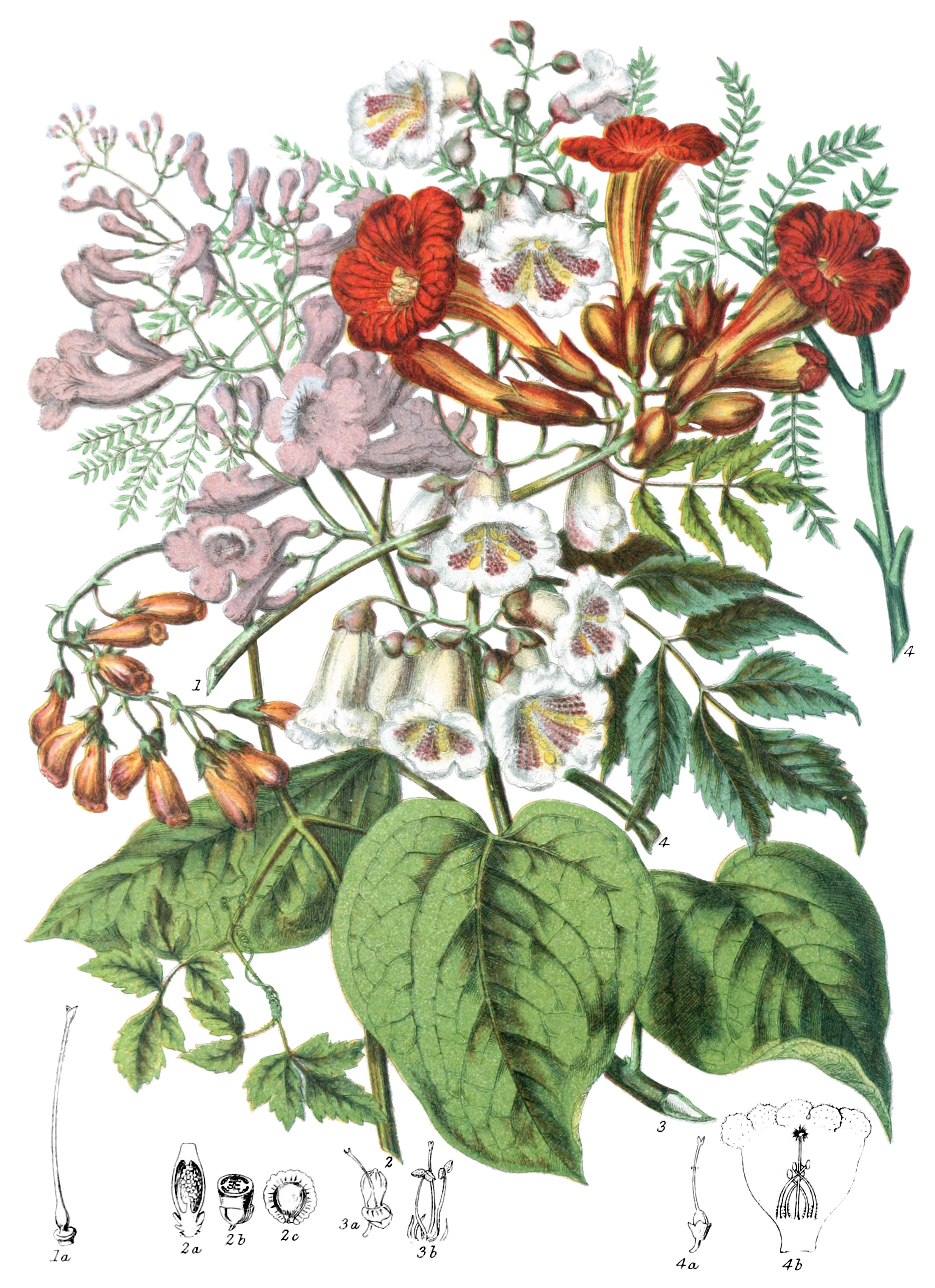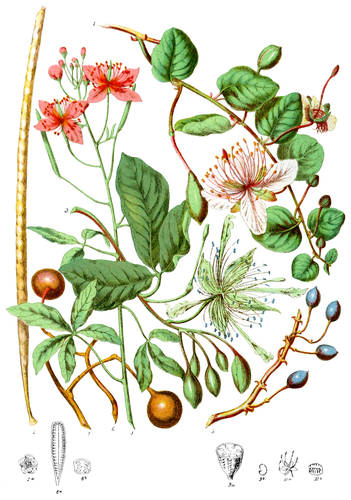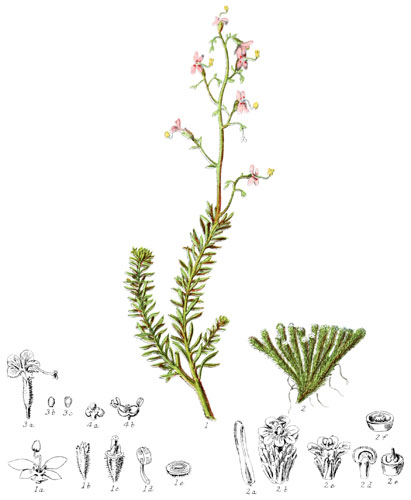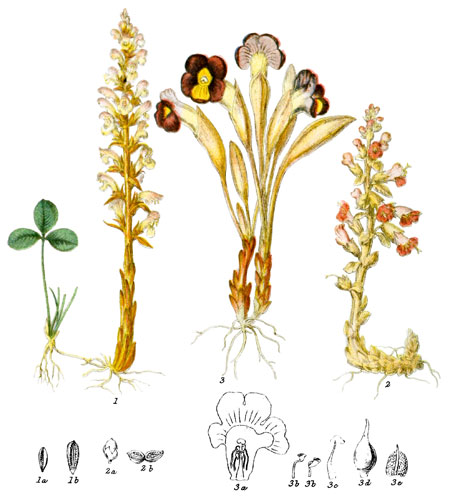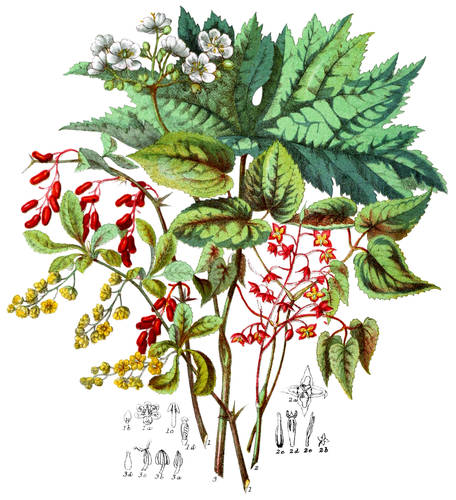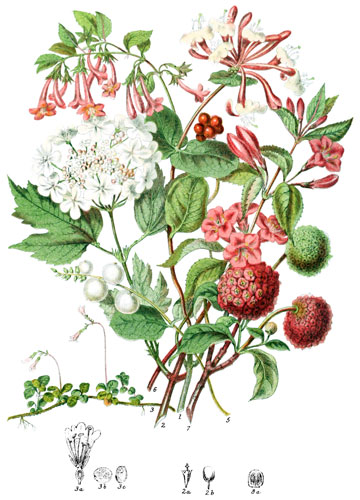Key characteristics
Trees, shrubs, and a few herbaceous plants; often twining or climbing. The leaves are opposite, very rarely alternate, compound or someitmes simple, without stipules, often with tendrils. The flowers are at the ends of branches, in loose panicles. The calyx is entire or divided, sometimes a kind of sheath. The corolla is of one petal, attached to the base of the ovary, usually irregular; four or five-lobed. The stamens are five, of unequal length, one or three imperfect; the anthers are two-celled. The ovary is placed in a disk, two-celled, or partially four-celled, containing many seeds. The style is single, the stigma is formed of two plates. The capsule is two-valved, two-celled, often long and compressed, sometiems imperfectly four-celled. The two plates bearing the seeds meet in the axis and unite in Bignonia; in Eccremocarpus they adhere exclusively to the edges of the carpels. The seeds are transverse, compressed, winged, without albumen.
This Tribe is related to several others of similar appearance in inflorescence, but the winged seeds fixed to a plate distinguish it from all.
Bitter and muscilaginous properties exist in the bark.
Select plants in this order
Not all plants listed are illustrated and not all plants illustrated are listed.
- Bignonia, the type of this Order, was named by Tournefort after his patron, the Abbé Bignon, librarian to Louis the Fourteenth. All the species are remarkable for beautiful flowers; some are large trees in the forests of Brazil, and yield excellent timber for ships; the Ipeuma furnishes the hardest wood in Brazil; another species, called the Pao d’arco, is found by the natives to be peculiarly well adapted for making bows.
- B. capreolata and others show very distinctly the curiously lobed form of the wood, sometimes having eight or sixteen divisions.
- B. radicans (1) is one of the most known in this country, in favourable situations remaining uninjured through the winter in the open air. It flourishes still more vigorously in Germany, and may be frequently seen there covering the walls of coursts of gardens.
- B. echinata has a prickly capsule; the branches are used medicinally.
- The leaves of B. chica yield when boiled a red starchy substance called chica, with which the South American Indians stain their bodies; it is also employed to give an orange-red hue to cotton.
- The tough and supple young branches of B. cherere are woven into a kind of wocker-work.
- The bark of B. leucoxylon is considered a valuable antidote to the poisonous Manchineel tree, Hippomane Mancinella among Euphorbiaceæ.
- B. multijuga of the Silhet mountains, in India, bears a slender flat pod fourteen inches long, containing numerous winged membranaceous delicate seeds.
- B. xylocarpa has a tuberculated seed-vessel three feet long, as large as a walking-stick; a very remarkable appearance have these pods hanging in abundance from the trees in Malabar Ghauts.
- Eccremocarpus, named from its pendent seed, is a very elegant genus; E. scaber (2) is now become a frequent inhabitant of our gardens, climbing over trellis-work or walls in a southern position, and is of extremely elegant growth.
- Catalpa, the Indian name in North America, is one of the most beautiful of the flower trees introduced to Europe.
- The leaves of C. syringifolia (3) come forth late in the season, but are large and of bright green; when the numerous spikes of delicately coloured flowers appear towards the end of July, the graceful beauty of its aspect can scarcely be surpassed. The long seed-vessels are rarely produced in this country; in America, a decoction made from them is said to be a remedy for coughs. Although of so tender an appearance, these trees are able to endure the smoky atmosphere of large cities; one of the first seen here was planted by Lord Bacon in the gardens in Gray’s Inn, London, and as well as one in Lincoln’s Inn, blossoms freely in summer.
- C. longissima of the West Indies is a taller species, with oblong wavy leaves.
- Jacaranda (4) retains its Brazilian appellation; all the species have extremely graceful foliage, resembling that of ferns in general character; in our conservatories, they grow freely in foliage, but seldom bear flowers.
- Tecoma is a Mexican genus, growing also in Brazil and at the Cape of Good Hope; like others of this tribe, it has brilliant flowers, and contributes to the embellishment of the world.
- Some of the species have useful properties; T. impetiginosa contains a large portion of tannin, and its bitter mucilaginous bark is employed for medical baths and other purposes. The leaves have also valuable healing qualities.
- Incarvillea is indigenous to China and Japan, and also has been discovered on the Himalayas.
- Amphicome arguta grows in Kunawu; the seed-vessel is a slender pod, of nearly similar appearance to some of the cruciferous plants.
- Trigonocarpus belongs to the Burmese coast, Schrebera to the south of India, Wightia to Nepal.
- Fieldia is a native of New Holland.
Locations
The plants of this Tribe adorn the Tropical countries of both hemispheres; some extend to the north as far as Pennsylvania in North America; others southwards to the southern parts of Chile in South America. None belong to Europe.
Legend
- Bignonia radicans, Trumpet-Flower. North America.
- Ovary and Pistil.
- Winged Seed.*
- Eccremocarpus scaber, Rough Eccremocarpus. Chile.
- Section of Ovary.
- Cross Section.
- Seed.
- Catalpa syringifolia, Common Catalpa. North America.
- Calyx and Pistil.
- Stamens and Pistil.
- Jacaranda mimosifolia, Mimosa-leaved Jacaranda. Brazil.
- Calyx and Pistil.
- Flower opened.
*1a was mentioned in the original description but not illustrated.
Explore more
Posters
Decorate your walls with colorful detailed posters based on Elizabeth Twining’s beautiful two-volume set from 1868.
Puzzles
Challenge yourself or someone else to assemble a puzzle of all 160 botanical illustrations.
